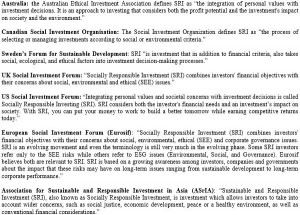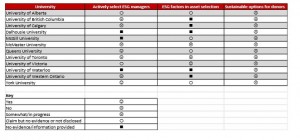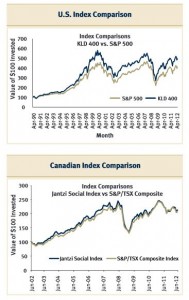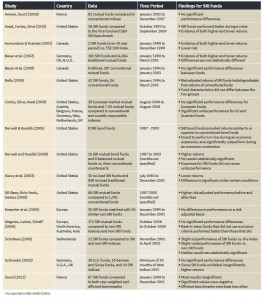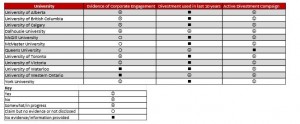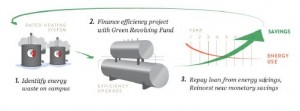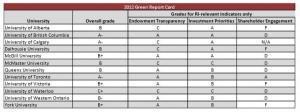March 5th, 2014
Erik Chevrier
The primary purpose of this report is to make recommendations to the Joint Responsible Investment Working Group (JRIWG) on how to implement a socially responsible investment plan. As a secondary purpose, this report could also be used to guide present and future investments made by the Concordia Student Union (CSU)i. Finally, this report is intended to be disseminated to the public at large in order to provide a transparent account of the findings, process, and documents provided to the JRIWG that stems from the socially responsible research project.
In this report I recommend the following actions to the Concordia Foundation:
1 – The Concordia Foundation should abide by the six PRI principles and sign the PRI declaration.
1.2 – The Concordia Foundation should communicate and collaborate with other Canadian Universities who have adopted, are in the process of adopting or are considering adopting PRI criteria to guide their investments.
2 – The Concordia Foundation should adopt an SRI plan over and above the PRI
3 – The Concordia Foundation should strongly consider negatively screening fossil fuels and tar-sand production.
4 – The Concordia Foundation should participate in targeted/community investing
5 – The Concordia Foundation should establish a formal committee to implement and oversee the SRI plan
Background
Students at Concordia University are concerned about the investment practices of Concordia University and the Concordia Foundation. At their general assembly in November 2013, Graduate Student Association (GSA) members passed a motion to “pressure the University to move away from fossil fuel technology and infrastructure.”ii The CSU is actively engaged in a campaign to encourage Concordia to divest from fossil fuels. On their website, the CSU state that the main goal of their divestment campaign is to,
“have the university divest its endowment funds (the revenues it holds in private investments) from the fossil fuel industry and as well as any other holdings deemed socially, environmentally, or economically unsustainable.” iii
In September 2013, the CSU began an action oriented research projectiv to analyze Concordia’s current investment practices and to make recommendations to the Concordia Foundation about how to develop a socially responsible investment plan. In November, a report was produced on the Concordia Foundation’s investment practicesv.
To summarize the report, the Concordia Foundation holds $142 million dollars in investments: 61% in pooled funds, 27% in bonds and 11% in common shares. The report could not identify which specific types of investments were made by the Concordia’s Foundation because the only information provided to the CSU about the Concordia Foundation’s common shares was from their yearend financial statements of 2011, 2012, and a draft statement from 2013. The Concordia Foundation’s financial statements are vague when referring to the types of investments – they only report the name of the industry that they invest in and not the names of the companies within the industries themselves. For example, we know that the Concordia Foundation currently holds about $900 thousand in energy investments and that in 2012 they held about $12 million. We don’t know which energy companies were receiving the investments in those years, nor do we know what types of energy companies received investments (renewable vs non-renewable). Adding to the confusion, a significant portion of the Concordia Foundation’s investments are in pooled funds. Pooled funds are dynamic, they change over time. To understand which specific companies or types of industry receive investments from the Concordia Foundation’s pooled funds would require a process of tracking over time. Instead, the CSU and Concordia Foundation decided to create a Joint Responsible Investment Working Group (JRIWG) for the purpose of considering developing a socially responsible investment plan for the Concordia endowment.
In January 2014, the JRIWG met for the first time. The meeting consisted of an introduction, and general discussion of SRIs. Present at the meeting was Bram Freedman (president of the Concordia Foundation President), Howard Davidson (chair of the Concordia Foundation), Patricia Saputo (board member of the Concordia Foundation), Caroline Bourbonniere (representative of the CSU), Lex Gill (representative of the GSA), Marc Gauthier (university treasurer), Anthony Garoufalis-Auger (representative of the Arts and Science Federation of Associations; ASFA) and Erik Chevrier (SRI researcher for the CSU). As a tangible outcome of the meeting, the group agreed to meet again and continue to discuss the possibility of implementing an SRI plan for Concordia`s endowment. This meeting will take place on March 10, 2014. The agenda consists of a presentation by Erik Chevrier on how Concordia could develop a socially responsible investment plan and by Anthony Garoufalis-Auger on the impact of oil companies on our environment. Moving forward, this report outlines my recommendations to the Concordia Foundation. I begin by unpacking important terminology in order for all parties to know specifically what is being discussed. First and foremost, I define socially responsible investing.
What is Socially Responsible Investing?
Socially responsible investing is the process of selecting or managing investments according to ethical criteria. an SRI portfolio takes into consideration non-financial – i.e. ethical and social factors. Cowton (1994) captures the essence of an SRI in his description of ethical investing. Cowton (1994) wrote,
“Ethical investment may be defined as the exercise of ethical and social criteria in the selection and management of investment portfolios, generally consisting of company shares (stocks). This contrasts with standard depictions of investment decision-making in finance textbooks, which concentrate solely on financial return in the form of dividends and capital gains, and risk..” (Cowton 1994, p. 215).
Following the 2006 OECD roundtable on corporate responsibility, the OECD produced a report (2007) on the roundtable. This report provided several definitions for SRIs from around the worldvi. These definitions are listed in Figure 1.
Figure 1. Definitions of Socially Responsible Investments from Around the World
Source: OECD Report on the Roundtable on Corporate Responsibility (2007)
http://www.oecd.org/investment/mne/38550550.pdf
The OECD (2007) suggested that, historically, SRIs have fallen under three categoriesvii:
1 – Social factors: human capital (training and education, working conditions, and health), community development, labour rights (such as the right to unionization);
2 – Environmental factors: urban and industrial pollution, global warming, depletion of some natural resources (such as oil) and restricted access to others (such as clean water), the reduction of the world’s flora and fauna populations;
3 – Ethical factors: violations of human rights, use of child labour, manufacture or distribution of weapons, inhumane testing of products on animals, implicit support of oppressive political regimes, slavery, forced prostitution, as well as the traditional ethical concerns around pornography, alcohol and gambling.
The United Nations use the term responsible investing, (RI) rather than socially responsible investing, to refer to ethical investment practices. Through an initiative developed by the United Nations known as the Principles for Responsible Investments (PRI), six principles are outlined to guide responsible investments. The six principles for responsible investing developed by the United Nations are as followsviii:
1 – We will incorporate ESG issues into investment analysis and decision-making processes.
2 – We will be active owners and incorporate ESG issues into our ownership policies and practices.
3 – We will seek appropriate disclosure on ESG issues by the entities in which we invest.
4 – We will promote acceptance and implementation of the principles within the investment industry.
5 – We will work together to enhance our effectiveness in implementing the principles.
6 – We will each report on our activities and progress towards implementing the principles.
Institutions that agree to abide by these investment principles can sign declaration on the PRI websiteix.
Recommendation 1 – The Concordia Foundation should abide by the six PRI principles and sign the PRI declaration.
There are many reasons why the Concordia Foundation should adopt the PRI principles. First of all, Concordia should only invest in companies that have strong environmental, social and governance (ESG) ratings because Concordia has committed itself to “responsible environmental stewardship and sustainability through all the Universities activities and functionsx”. This includes the companies that Concordia contractsxi, the companies that Concordia allows to perform their researchxii, and the companies that Concordia invests inxiii.
Although Concordia prides itself as being a leader in sustainability, the Concordia Foundation does not have an SRI plan as of yet. The report, Concordia: An Economic Force Connected to its Community: Study on the Impact of Concordia University, statesxiv
“Concordia is committed to leading in sustainability. It has undertaken to raise public awareness and promote innovation to address the issues involved. This initiative is a demonstration of its resolve to democratize access to knowledge and expertise, and to engage the community in dialogue through various events outside the traditional educational framework. Thanks to its many activities, Concordia organizes citizen participation and encourages its employees, professors and students to participate in the many social initiatives offered in its environment. Always dynamic, the university stands out as an engaged and thoroughly engaging institution.” (p. 7)
Secondly, Concordia can follow the example of the two Canadian Universities who have signed the PRI declaration and abide by the six principles: Ottawa University and Université de Montréal (Régime de Retraite). Although they did not officially sign the PRI declaration, the following universities incorporate PRI criteria into their investment practices.
- York Universityxv
- University of Victoriaxvi
- University of Western Ontario (They have an SRI fund in their portfolio)xvii
- Queens University (requires that an asset manager have expertise in ESGs)xviii
- University of Toronto (requires that an asset manager have expertise in ESGs)xix
- University of British Columbia (incorporates ESGs only when it doesn’t hurt returns)xx
- McGill University (has an SRI fund)xxi
- Colleges of Applied Arts and Technology Pension Plan (encourages the consideration of ESG criteriaxxii
- Concordia University (pension plan encourages the inclusion of ESGs)xxiii
A study by the Coalition of Universities for Responsible Investing (CURI) looked at the investment practices of universities with the twelve largest endowment funds. Five of the twelve universities claim to actively select ESG managers and to have ESG factors in asset selection. See Figure 2 for an overview of the CURI study.
Figure 2. CURI Study: Twelve Largest Canadian University Endowment & Participation in ESG
Source: CURI
http://carleton.ca/3ci/wp-content/uploads/benchmarking-study_curi_june-2013_final1.pdf
Like the Concordia Foundation, other Canadian Universities (i.e. Brock Universityxxiv), are currently considering adopting PRI criteria. The Concordia Foundation should communicate with these universities, as well as those who signed the PRI declaration and the universities who incorporate elements of the PRI. Collaboration between universities institutions could facilitate the adoption of a successful SRI because each institution could learn from each other’s successes and failures.
Recommendation 1.2 – The Concordia Foundation should communicate and collaborate with other Canadian Universities who have adopted, are in the process of adopting or are considering adopting PRI criteria to guide their investments.
Third, evidence suggests that ESG investments are not more risky, or produce less return; in fact they may even outperform traditional investments. A meta-analysis conducted by the Deutsche Bank Group (2012) demonstrated that incorporating ESG screening can have a positive impact on returns. They state thatxxv,
- 100% of the academic studies agree that companies with high ratings for Corporate Social Responsibility (CSR) and ESG factors have a lower cost of capital in terms of debt (loans and bonds) and equity. In effect, the market recognizes that these companies are lower risk than other companies and rewards them accordingly. This finding alone should put the issue of Sustainability squarely into the office of the Chief Financial Officer, if not the board, of every company.
- 89% of the studies we examined show that companies with high ratings for ESG factors exhibit market-based outperformance, while 85% of the studies show these types of company’s exhibit accounting-based outperformance. Here again, the market is showing correlation between financial performance of companies and what it perceives as advantageous ESG strategies, at least over the medium (3-5 years) to long term (5-10 years).
- The single most important of these factors, and the most looked at by academics to date, is Governance (G), with 20 studies focusing in on this component of ESG (relative to 10 studies focusing on E and 8 studies on S). In other words, any company that thinks it does not need to bother with improving its systems of corporate governance is, in effect, thumbing its nose at the market and hurting its own performance all at the same time. In the hierarchy of factors that count with investors and the markets in general, Environment is the next most important, followed closely by Social factors.
- Most importantly, when we turn to fund returns, it is notable that these are all clustered into the SRI category. Here, 88% of studies of actual SRI fund returns show neutral or mixed results. Looking at the compositions of the fund universes included in the academic studies we see a lot of exclusionary screens being used. However, that is not to say that SRI funds have generally underperformed. In other words, we have found that SRI fund managers have struggled to capture outperformance in the broad SRI category but they have, at least, not lost money in the attempt.
Another study done by Eccles, Ioannou, Serafeim (2011)xxvi, used a matched sample of 180 US companies looking at long term market performance. Eccles et. al. (2011) found that ‘high sustainable’ companies outperform ‘low sustainable’ companies over the long term.
A study published by the Royal Bank of Canada (RBC) demonstrates that SRI stocks, like the KLD 400 and the Jantzi Social Index, outperform traditional stocks (like the S7P 500 and the S&P TSX Composite index) in both Canada and the United Statesxxvii. See Figure 3 for a graph of stock comparisons.
Figure 3. RBC Graph of SRI Stocks vs Traditional Stocks
Source: RBC Report: Does Socially Responsible Investing Hurt Investment Returns?
http://funds.rbcgam.com/_assets-custom/pdf/RBC-GAM-does-SRI-hurt-investment-returns.pdf
A meta-analysis provided by in the RBC report suggests that there is no conclusive evidence that SRIs outperform or underperform conventional stocks. A summary of the RBC meta-analysis is provided in Figure 4.
Figure 4 – RBC Meta-Analysis on Academic Literature on SRI Performance
Source: RBC Report: Does Socially Responsible Investing Hurt Investment Returns?
http://funds.rbcgam.com/_assets-custom/pdf/RBC-GAM-does-SRI-hurt-investment-returns.pdf
Original Source: ABN-AMRO Asset Management, Does Socially Responsible Equity Portfolios Perform Differently from Conventional Portfolios? If So: How and Why? (September 2001).
Evidence suggests that if the Concordia Foundation adopted the PRI model, most likely, stocks will perform in a similar fashion as they do presently.
Recommendation 2 – The Concordia Foundation should adopt an SRI plan over and above the PRI
Developing an SRI plan encompasses more than the six Principles of Responsible Investment. At the first JRIWG meeting, Bram Freedman distributed a presentation on how to build a responsible investment plan from SHARExxviii. In this document, SHARE describes SRI practices over and above the six PRIs. The practices outlined by SHARE are similar but not identical to their other models. In order to get a comprehensive overview of SRI practices, I formed a list of SRI practices amalgamating SHARE’s model with three other models from other consulting firms: Strandberg Consultingxxix, Responsible Investment Associationxxx, and Ocean Rock Investments Inc.xxxi. According to four SRI consulting firms, these are the following practices that may be adopted when forming an SRI plan.
1 – Invest only in companies with high Environmental, Social, Governance (ESG) ratings.
2 – Screen companies and/or industries based on specific criteria and/or requirements. Screens can be positive (selecting investments because of desired criteria) and/or negative (avoiding investments because of undesired criteria).
3 – Engage in shareholder advocacy by voting and/or creating proposals for general meeting from the companies in which shares are owned.
4 – Invest in high impact community projects and/or sustainable venture capital initiatives – i.e. social economy, local businesses, green revolving funds, micro-credit organizations, etc.
5 – Disclose information about SRI engagement – i.e. positions taken in proxy votes, SRI plan, information about positive and negative screens, etc.
6 – Engage and communicate with stakeholders to identify their investment priorities.
7 – Advocate improving public policy on corporate accountability, financial transparency and corporate accountability.
8 – Participate in educating the public about the importance of environmental sustainability and SRIs.
9 – Cooperate and collaborate with other institutions to develop an integrated SRI plan.
10 – Provide transparent reports about the performance of the SRI plan to trustees, stakeholders and the general public.
11 – Communicate regularly with investment managers.
The most comprehensive single model is provided by Strandberg Consulting. Their model is provided in Figure 5.
Figure 5 – Strandberg Consulting list of SRI Components
Source: Strandberg Consulting
http://corostrandberg.com/wp-content/uploads/files/SRIComponents.pdf
CURI suggests that universities should be participating in screening (positive and negative), proactive investing (economically targeted, community initiatives, mission related) and corporate engagement (proxy voting, dialogue, media campaigns, threat of divestment).
Other Canadian universities engage in SRI practices over and above the six PRI. The study published by CURI on the investment practices of the twelve largest Canadian University endowments demonstrates four universities claim that they perform corporate engagement and that negative screening has been used by Queens University within the last 10 years – Queens divested from tobacco products Figure 6 displays CURI’s chart.
Figure 6 – CURI Study: Corporate Engagement and Divestment
Source: CURI
http://carleton.ca/3ci/wp-content/uploads/benchmarking-study_curi_june-2013_final1.pdf
Another sourcexxxii demonstrates that divestment campaigns are present in the following universities: Lethbridge (tobacco), University of Toronto partial divestment from tobacco, McGill (Sudan, Tobacco), Dalhousie (Tobacco) and University of British Colombia (South Africa).
CURI’s study also demonstrates that every university in their study except the University of Calgary has an active campaign to divest from fossil fuels and or tar-sand development. Other sources confirm that campaigns to divest from fossil fuels and tar-sands are present in almost every Canadian Universityxxxiii.
Recommendation 3 – The Concordia Foundation should strongly consider negatively screening for fossil fuels and tar-sand production.
The argument for this was be presented by Anthony Garoufalis-Auger at the last JRIWG meeting. A link to Anthony’s presentation will be provided in the appendix shortly. For now, please reference, The Fossil Fuel Industry and the Case for Divestmentxxxiv, produced by Toronto350.org. In this document, they present a persuasive argument as to why universities should divest from oil.
Recommendation 4 – The Concordia Foundation should participate in targeted investing
There are many targeted investment funds that can tremendously benefit Concordia University. For example, Sustainable Action Fund is promoting the idea of creating a green revolving fund. The idea of a green revolving fund is to start with seed money and fund infrastructure improvements and eliminate waste. By eliminating waste, money is saved. This savings can be reinvested into other capital improvements – which can, again, reduce waste and save the institution more money – and/or used to pay back the initial investment. See figure 7 for a pictorial graphic of a green revolving fund. See appendix A for a report on Green Revolving Funds co-publication of the Sustainable Endowments Institute & the Association for the Advancement of Sustainability in Higher Education.
Figure 7 – A Green Revolving Fund
Source: Report on Green Revolving Funds co-publication of the Sustainable Endowments
Institute & the Association for the Advancement of Sustainability in Higher Education
http://www.aashe.org/files/documents/resources/grf_intro_guide.pdf
Green revolving funds are being developed in Canadian Universities including University of Victoria, University of Calgary, University of British Columbia, University of Alberta, and St John’s University.
Apart from green revolving funds, there are many other targeted investments that can be made. A great resource for understanding more about targeted investments in Canada can be found on Community Foundations of Canada websitexxxv. I suggest that a discussion on targeted investments/community investments be the focus of the next JRIWG meeting. This will give me more time to gather more research and make additional recommendations in regards to targeted/community investment possibilities.
Recommendation 5 – The Concordia Foundation should establish a formal committee to implement and oversee the SRI plan
Establishing the JRIWG was an important first step to begin a dialogue about socially responsible investments. If the Concordia Foundation agrees to adopt an SRI, a committee could facilitate this process. This committee could engage in proxy voting and/ or corporate engagement. They could monitor the performance of the ESG stocks, communicate to the public about investment practices and beliefs, and could look into high impact, targeted investment projects.
Other universities, like the University of Western Ontario have a specific board to discuss investment issues and strategies.
Conclusion
The Concordia Foundation currently has no SRI in place and would receive a failing grade on the CUSI sustainable investment chart (see figure 8). This is unacceptable for an institution that claims to be a leader in sustainable initiatives. It is time to change our investment behaviour and adopt an SRI plan. Moving forward, I suggest that the board of the Concordia Foundation formally express their intentions to pursue an SRI plan, and intentions to adopt the recommendations outlined in this report. Following that, we may have targeted discussions about how to implement an SRI plan with the Concordia endowment.
Figure 8 – CUSI Rating of Canadian University SRI Practices
Source: CURI
http://carleton.ca/3ci/wp-content/uploads/benchmarking-study_curi_june-2013_final1.pdf
To reiterate, I recommend that the Concordia Foundation:
1 – The Concordia Foundation should abide by the six PRI principles and sign the PRI declaration.
1.2 – The Concordia Foundation should communicate and collaborate with other Canadian Universities who have adopted, are in the process of adopting or are considering adopting PRI criteria to guide their investments.
2 – The Concordia Foundation should adopt an SRI plan over and above the PRI
3 – The Concordia Foundation should strongly consider negatively screening fossil fuels and tar-sand production.
4 – The Concordia Foundation should participate in targeted investing
5 – The Concordia Foundation should establish a formal committee to implement and oversee the SRI plan
References
Cowton, C. J. (1994). ‘The Development of Ethical Investment Products.’ Published in The ACT Guide to Ethical Conflicts in Finance, p. 213-232. Oxford, UK: Blackwell Publishers.
Eccles, Ioannou and Serafeim, (2011) The Impact of a Corporate Culture of Sustainability on Corporate Behavior and Performance. Harvard Business School,
Smith (2006), Political Activist as Ethnographer. In, Frampton, C., Kinsman, G., Thompson, A. K., Tilleczek, K. (2006) Sociology for the Changing World: Social Movements/Social Research, Fernwood Publishing.
Indvik, J., Foley, R., Orlowski, M., 2013. Green Revolving Funds: A Guide to Implementation & Management. Co-publication between Sustainable Endowments Institute (SEI) and the Association for the Advancement of Sustainability in Higher Education (AASHE).
Indvik, J., Foley, R., Orlowski, M., 2012. Green Revolving Funds: An Introductory Guide to Implementation and Management. Co-publication between Sustainable Endowments Institute (SEI) and the Association for the Advancement of Sustainability in Higher Education (AASHE).
Footnotes
i The CSU has over $13 million in reserve to build a student center or related infrastructure This money could be invested in a socially responsible manner until the funds are used. Obviously, this amount is not as large as the assets held by the Concordia Foundation (about $140 million). Nonetheless, smaller funds can be invested in a socially responsible way as well.
ii Minutes from the Graduate Student Association general assembly on November 8th, 2013.
“6.1 – Be It Resolved That [the] GSA follow more sustainable meeting practices and pressure the University to move away from fossil fuel technology and infrastructure […] Passed by [a] large majority”.
iv Action based research is a method of inquiry that’s goal is to produce some form of social change. The goal of an action based research project is to transform problematic elements of society by challenging the rhetoric of the “political ruling regime” (Smith, 2006, p. 48). In the case of the CSU research project, the goal is to investigate Concordia’s investment practices and, more importantly, to assist Concordia in adopting socially responsible investment practices. The methodology used to produce this report stems from Smith (2006). He suggested that activist ethnographers focus on six main features. First, they suggest that the basis of any inquiry should begin with the actual experiences of people who are facing problems that the researcher is trying to fix. Second, they propose that activist researchers use an ontological approach that is constituted in the everyday lives of the people being studied. Third, they stressed the importance of describing the notion of social relations from the lives of the everyday people who are being studied. Fourth, they recommended using the information from meetings with government officials and professionals as ethnographic data. Fifth, they suggested that activist researchers use texts that describe how the problematic regime functions. These texts include government reports, media sources, annual reports, etc. Sixth, they cautioned against using traditional explanations of social phenomena because these explanations only uphold the values of the problematic ruling regime.
vThe report is available online at: https://erikchevrier.ca/research/ethical-investment-research-for-the-concordia-student-union
vi Report on the OECD Roundtable on Corporate Responsibility (2007). The report can be found at the following web address: http://www.oecd.org/investment/mne/38550550.pdf
vii ibid
viii The six principles for responsible investing can be found at the following web address: http://www.unpri.org/about-pri/the-six-principles/
ixThe list of signatories can be found at the following web address: http://www.unpri.org/signatories/signatories/
x Concordia’s environmental policy preamble, “Concordia University is committed to responsible environmental stewardship through all the University’s activities and functions. While recognizing that every member of the University community shares in this responsibility, the University shall provide leadership through its operations, teaching and research. The University shall strive to be at the forefront of environmental leadership and shall encourage University community members to begin initiatives in line with concepts outlined in this policy.” http://www.concordia.ca/content/dam/common/docs/policies/official-policies/VPS-5.pdf
xi Concordia’s environmental policy on contracting companies” All planning, construction and renovation projects undertaken by the University shall consider employing universal barrier-free design, locally-produced, reused, recycled and/or sustainably harvested materials as well as recycling and/or reusing demolition, renovation and construction waste. Green building principles shall be utilized where financially feasible in all significant projects, incorporating issues such as optimal energy efficiency, life-cycle costs, high indoor environmental quality, and reduced water consumption, to minimize environmental degradation and enhance the well-being of the University community. Whenever financially feasible, renewable energy sources shall be implemented to meet the University’s energy needs.” http://www.concordia.ca/content/dam/common/docs/policies/official-policies/VPS-5.pdf
xii Concordia’s policy on research and the environment, “Sustainability is a major focus of the technology industry and the environmental cluster where researchers are examining some of the most pressing environmental concerns of our time, including the impact of human activity, geopolitical trends, environmental risk factors and resource scarcity. In response, Concordia researchers are seeking new society‐wide ways of decreasing our environmental footprint and reconceiving and redesigning the energy systems we use, the items we manufacture and the buildings we live in.” http://www.concordia.ca/content/dam/concordia/services/research/docs/Strategic_Research_Plan_2013-2018.pdf
xiiiConcordia’s environmental policy on commodity purchasing,. Derivative trading involves purchasing future commodities, ” Wherever feasible in terms of financing, sourcing and availability, the University shall attempt to purchase goods that are ecologically benign, including items that are energy efficient, locally produced, made from post-consumer recycled and/or renewable materials, are recyclable, non-toxic and/or organic, should they meet or exceed the requirements as specified by the departmental end users. The University shall also work to consider life cycle costs and impacts when assessing products and equipment for procurement and, when possible, will tender to suppliers that are local and/or committed to environmental sustainability” http://www.concordia.ca/content/dam/common/docs/policies/official–policies/VPS-5.pdf

